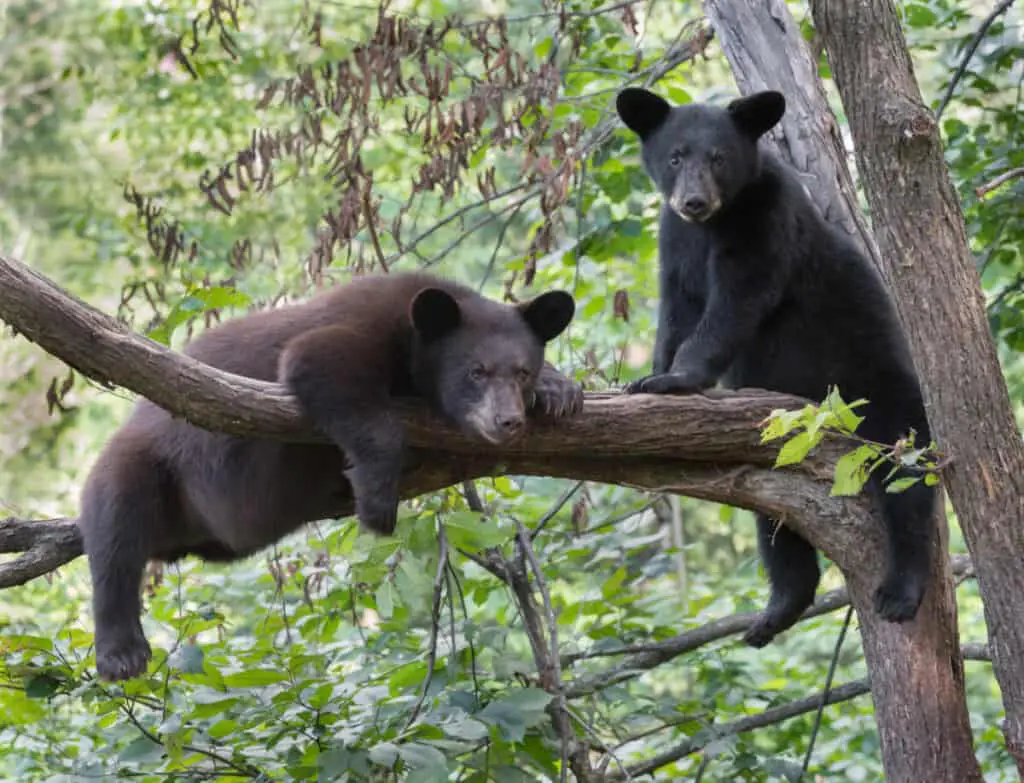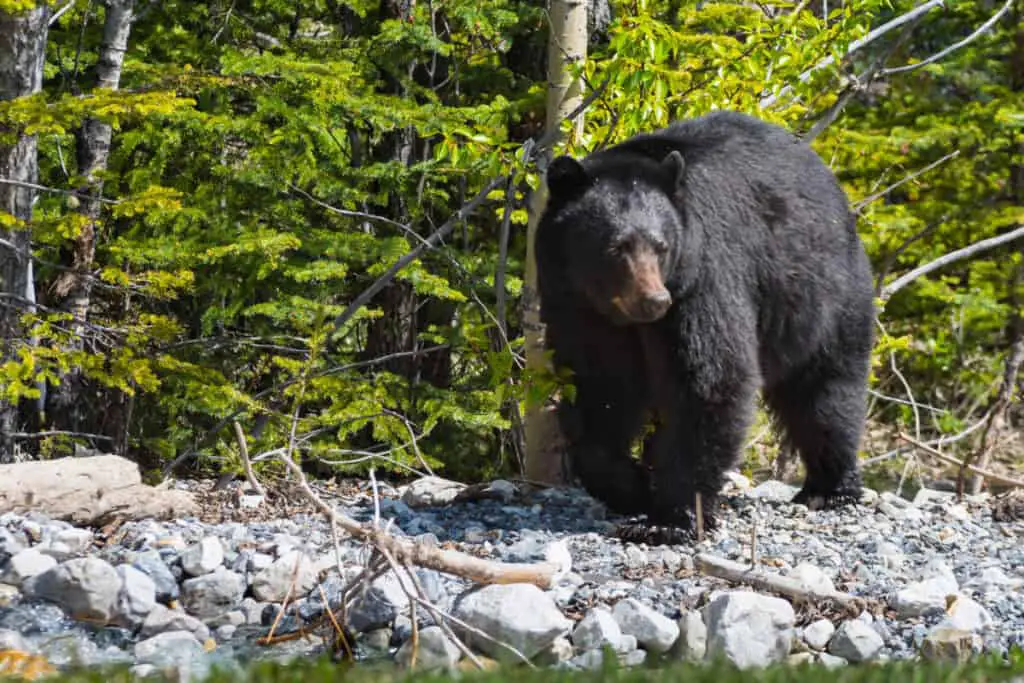American black bears (Ursus americanus) are a species of bear that inhabit North America. They can be found in diverse habitats, ranging from the boreal forests of Canada to mountainous regions in Mexico.
This article provides an overview of the lifecycle of these iconic mammals with a focus on their behavior and ecology.
The life stages for most mammalian species commonly include birth, juvenile development, adulthood and death; however, there is much variation among individual animals within each stage.
In particular, age-related changes in diet, habitat use and social behaviors are key components to understanding how black bears interact with their environment over their lifetime.

Birth And Juvenile Development
American black bears (Ursus americanus) are born with the instinct to survive and find a suitable habitat. Upon birth, they weigh only eight ounces and rely on their mother’s nursing habits for the first few months of life.
During this period, cubs grow rapidly in size due to their high-fat milk diet from their mothers.
When juveniles reach about four months old, they begin to explore outside of the den with their mother and learn important skills such as habitat selection and food acquisition.
Cubs remain under maternal care until reaching one year or more depending on environmental conditions; during this time, they develop physical traits like fur coloration which helps them blend into different environments and avoid predation.
At approximately two years old, juvenile black bears become independent after leaving their mother’s side permanently.
Diet And Foraging
Previous research has proposed that American Black Bears (Ursus americanus) rely on a wide variety of foods, ranging from nuts and berries to fish and small mammals. However, recent studies have revealed that the specific diet of these bears is dependent upon their geographic location; those living in mountainous regions are more likely to consume vegetation while coastal populations tend to eat mainly seafood.
This species’ foraging behavior also varies based on its environment: when food sources are abundant, they will spend less time eating, spreading out their meals throughout the day rather than consuming all at once. Conversely, if resources are scarce or seasonal, they may feed intensively during certain times of year.
In either case, American black bears can be opportunistic scavengers as well as active predators depending on the availability of prey items such as insects, ground squirrels, salmon eggs and carrion. As a result of this dietary flexibility combined with adaptability to changing environments, this species is able to survive in numerous ecosystems across North America.
American black bear diets consist primarily of plant material supplemented by animal matter including invertebrates like ants and bees; berries; fruits; seeds; nuts; mushrooms; grasses; roots and tubers; fish and other aquatic animals found in streams and rivers; large ungulates like deer and elk hunted occasionally or scavenged dead carcasses; rodents such as mice and voles taken mostly through hunting but sometimes scavenging too; plus bird eggs collected seasonally.
Additionally, they often take advantage of human-related food sources like garbage dumps or pet food left outdoors. By relying on an omnivorous diet featuring both plant-based items and animal proteins for sustenance, these creatures demonstrate remarkable versatility in terms of where they live and what type of resources are available in each habitat.
Denning And Hibernation
American black bears typically enter the denning period in October or November and emerge from hibernation between March and April.
Den construction is an important activity for a bear before winter arrives as it provides insulation, protection from predators, and can be used to raise cubs when they are born.
Once inside their den, most American black bears will remain inactive until springtime; however, some may wake up during warm spells of weather.
Signs that indicate a bear has gone into hibernation include decreased respiratory rate, body temperature reduction by several degrees Celsius, reduced heart rate, and slowed metabolic rate.
During this time of dormancy, fat stores accumulated over summer months provide energy for the bear’s survival during the cold temperatures of winter.
Bears often lose 15-25 percent of their total body weight while hibernating due to these lowered energy requirements.
In addition to periods of deep sleep, which last several days at a time throughout winter months, bears may also experience shorter bouts of waking where they adjust position within their den or groom themselves with tongue and claws.
Social Interactions
American black bears exhibit a wide range of social behaviors. These include hierarchical behavior in which dominant individuals are generally older, larger males that establish and defend territories from other bears. This is done through vocalizations, scent marking, or physical confrontations between competing animals.
Social hierarchies within populations can vary depending on the availability of food resources; females may be more aggressive when defending denning sites with their cubs during times of high competition for resources such as salmon runs or berry patches.
The home ranges of American black bear overlap significantly and they often tolerate each other’s presence near shared food sources without showing aggression. However, individual encounters among conspecifics outside these areas can become quite intense due to territoriality and resource-based conflicts.
As with most mammals, male American black bears tend to display higher levels of aggression than female counterparts, particularly during mating season when males seek out receptive mates by aggressively challenging competitors and threatening potential rivals.
Mating And Reproduction
American black bears mate between May and July, with peak mating activity occurring during mid-June. During this time, male bears often congregate in areas where the female population is most concentrated.
This gathering of males allows for a competitive environment where one dominant bear will be chosen by several females to become their mate for that breeding season.
Females are selective when it comes to choosing mates; they prefer larger males as well as those with access to abundant food sources such as berry patches.
After mating occurs, the fertilized egg does not implant until November or December and then the mother carries her cubs through hibernation until early spring when she gives birth in her den.
All mothers nurture their young until they reach maturity at around two years old, after which point they can begin reproducing themselves.
Mortality And Longevity
American black bears have an average life span of 18-20 years in the wild. However, mortality rates and longevity can vary greatly depending on a variety of factors such as environmental conditions, predation, and human activities.
Aging is also important to consider when studying black bear lifecycles; young bears age faster than older individuals due to their more active lifestyles and higher exposure to risk from predators.
An interesting statistic related to American black bear survival is that cubs born with litters usually live longer than singleton cubs due to increased protection afforded by the mother’s presence.
Many studies have shown that increasing access to high quality food sources, such as those found in certain protected areas or forest habitats, can greatly improve bear health and lifespan.
Additionally, avoidance behavior towards humans has been identified as an essential factor for reducing mortality rates among American black bears.
As this species continues to be studied further its importance in maintaining healthy ecosystems will become increasingly clear.

Conclusion
The American black bear is a unique species, playing an important role in the North American ecosystem. It has adapted to its environment by developing behaviors and lifecycles that maximize survival chances and reproductive success.
The diet of this animal consists mainly of vegetation and insects, while denning and hibernation provide protection during cold seasons. Additionally, social interactions within groups are essential for mating purposes.
Mortality rates can be high depending upon human-related factors such as poaching or habitat loss; however, their average lifespan in the wild can reach up to 25 years with proper care.
To ensure these fascinating creatures continue roaming our forests, it is necessary to protect them so they can reach their full potential – like stars shining through the night sky!

